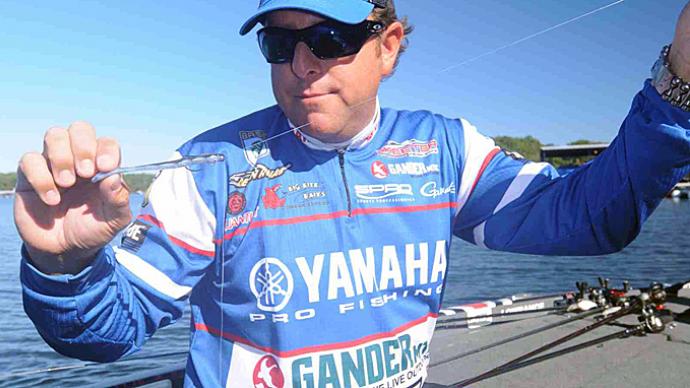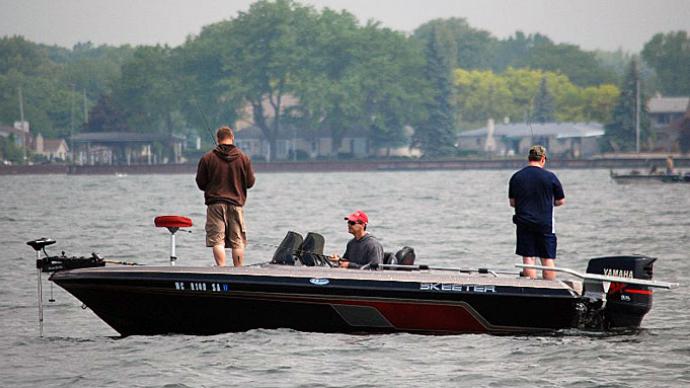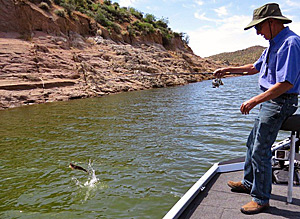
There’s no denying that drop-shotting is a deadly technique on western waters, but the pros know it’s a rig that works just about anywhere. It’s not always about hair-thin line and tiny baits, either. If the fish are slamming a spinnerbait or chasing plugs like there’s no tomorrow, you probably aren’t going to break out the spinning gear, but if the fish have lockjaw, read on for several killer drop-shot techniques that will work no matter where you live.
Heavy Line Drop-Shotting - John Murray
Murray is originally an Arizona boy who moved east to further his fishing career. He is probably one of the best-known and most respected fishermen in Arizona. He uses a drop-shot variation to catch inactive fish in shallow water and heavy cover like big weed beds. “If they’re on the outside, they’re active,” he says. “If you have to go in after them, they’re inactive.” Sometimes you have to tease them into biting, so he puts a five-inch Zipper worm (lots of action) on a big drop shot rig and uses that in the grass and weeds.
The rig is 16- to 25-pound fluorocarbon line with a ½ ounce or ¾ ounce bell sinker. Depending on where he’s fishing it, the leader can be anywhere from two to three feet up to 8 feet. Those long ones are for dropping or flipping next to submerged trees or standing timber. Just leave the weight next to the tree and shake the worm. A difference in leader length of just six to twelve inches can make a difference.
The action zone might be just six inches under the surface in a big weed bed, and if you throw a Texas rig in there, you’re past the strike zone in seconds. A drop shot lets you keep your bait where the fish are. Since this is an alternate method for inactive fish, it’s not a reaction bite. You just need to let it sit there, shake it, and tease them into eating. The key to success is that you can’t haul back and set the hook – pull or reel set. The fluorocarbon makes this pretty easy. A Senko is another dynamite lure for this technique if you can get it through.
Drop Shot For Summer Smallmouth - Takahiro Omori
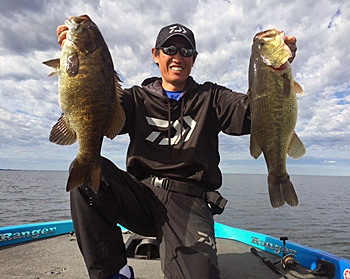
Takahiro is often on the big lakes in the northeast for summer tournaments, and a drop shot rig is one of his favorite ways to target smallmouth. It isn’t limited to the Great Lakes, of course – Takahiro says you should use it “anywhere there are smallmouth.” He uses a 7-foot-1 Daiwa Tatula spinning rod, medium action, and a Daiwa spinning reel spooled up with 7-pound-test Sunline FC Sniper fluorocarbon line to maximize his success. When fishing deep with small hooks, fluorocarbon is the way to go for sure hooksets.
Takahiro uses the big motor to find fish, observing his graphs. During the summer, he often finds them at 20 to 30 feet. He targets them with a green pumpkin 4-inch Yamamoto shad shape worm hooked through the nose. A ¼- to ½-ounce tungsten weight gets it down there, and he uses a 1/0 drop shot hook, the circle kind that looks like a live bait hook.
He starts graphing humps and points, and once he finds the fish, he gets right on top and drops the rig straight down to them. No casting. Once it hits bottom, he shakes it gently – just enough to wave the bait around. He says the waves and wind usually move it almost enough, so don’t go overboard with the shaking. Try to keep the movement realistic.
Smallmouth are usually offshore, and the time of the bite is also something you have to figure out. Another thing Takahiro does is that he sometimes uses scent. He’ll give the bait a shot of Bang or Gulp, and sometimes that helps. Also, move around – there will be different-sized fish on different humps. The school makes all the difference.
Some background information on Takahiro. This guy came to America from Japan in 1991 without knowing our language or having any friends. He fished his first B.A.S.S. Invitational in Texas that year. In 2001, he qualified for the Classic. He won it in 2004. This guy is amazing. Take a lesson from his life: he has worked with mental coaches, fitness trainers, nutrition counselors, and media experts to be the absolute best he can be. If you’re serious about becoming a true pro, you might want to take a closer look at Takahiro. He’s got a webpage: takahiroomori.com. Check it out.
Deadly Western Technique - Brent Ehrler
When does Brent fish a drop shot? All year long, especially out west. In winter, he fishes deeper. In spring, he fishes shallower – this time of year (pre-spawn), they’ll be on structure, staging on points and secondary points, heading toward the backs of coves to spawn. The drop shot is a fantastic rig during the spawn, and Brent throws it around grass, tules, docks, etc. Most of the time (90 percent), he uses spinning gear – specifically the rod he designed with Daiwa. It’s the Tatula 7-footer, and he designed it with a fast taper for easy casting. It has a good feel for drop shotting.
Ehrler uses a ¼-ounce Reins tungsten down shot sinker and nose-hooks his baits on a #1 Gamakatsu drop shot hook when using spinning gear. Twelve to fourteen inches is his standard leader length, and he uses 8-pound-test FC Sniper Sunline. If he’s using a baitcaster, he uses a 2/0 offset Gamakatsu hook and a ¼-ounce sinker. In this case, he rigs the worm weedless with about an 8-inch leader for around grass and other cover and uses 16-pound Sunline FC Sniper.
Keeping it simple, Brent has two favorite drop shot baits that he uses almost exclusively. First is the Yamamoto thin Senko, and second is the 4- or 6-inch Roboworm. Aaron’s Magic, Oxblood, Morning Dawn, and plain old green pumpkin are his favorite colors. The slim Senko is awesome rigged wacky, and the worms work too.
Regardless of how deep or shallow he is fishing, his technique is the same: when it hits bottom, shake it. Shake the worm without moving the weight. He doesn’t hop or drag it. He shakes it, so it’s barely moving, not jumping off the bottom or anything wild. Most of the time, he says, you won’t even know you’ve got a fish on until you move it. It’s not generally an aggressive bite, but it’s so effective that Brent recommends you go out and do it. It’s a deadly technique, even if they’re not biting.
Tips and Tricks - Gary Senft
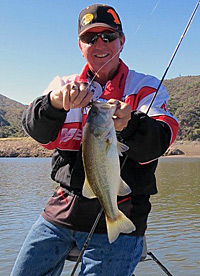
Gary Senft is one of the best-known bass fishermen in Arizona, and he’s been at it for decades. I’ve been out fishing with Gary many times, and he’s a drop shot pro if there ever was one. Here are some of the tips I’ve garnered from Senft over the past twenty-five years or so:
- If you’re dragging the rig, make the leader longer.
- Use a shake/drag technique to search for bass up shallow. Gary uses a lift and reel retrieve (like Texas fishing) unless the bite is tough. Then let it sit.
- To make it easier to change the leader length, tie a swivel hook to the line, then a long leader. Onto the leader, slip a bobber stopper, then the hook, another bobber stopper, then tie a cylinder weight to the bottom. Use one with a round eye or use a knife to round out the eye. The bobber stoppers let you change the hook position on the line, and Gary says it makes no difference on the hookset.
- Scent can make a difference, especially during a big tournament where there could be five to ten boats around you.
- If the bite is good, go to a bigger worm for bigger fish.
- Start on reefs before going deep.
- Bass Pro Excel line is economical and really good.
- If you’re fishing trees, just because the line feels heavy doesn’t necessarily mean it’s a fish. Shake it a couple of times. If it’s a fish, it will shake back. If not, just slowly move it out of the tree.
- Don’t listen to dock talk. You’ll hear a lot of lies putting you off your bite.
- 90 percent of the time, your bite will come within 90 seconds of your bait hitting bottom.
- Even if your partner is cranking, take a drop shot and throw it to the bank. Let it sit a bit, move it, then re-cast.
- Work a point all the way out, then down each side. Get on top and fish it uphill. Fish tend to congregate in one particular area. Find that sweet spot.
- Points with rocks or other structure on them are best, and the longer the point, the better.
- If your fish have moved after your prefish, check the points going out toward the main lake or toward the back. They probably haven’t moved far.
- If you’re not catching them on points, try 45-degree banks, especially in summer.
- Dropshot a creature bait using a size 1 offset wide gap hook – grab the hook's point with pliers and bend it just a tiny bit to the side – it will improve your hookset ratio.
- In a tournament, make ten or so casts. Move on if you’ve not received a bit. If you’re fishing with a partner and you’ve both made ten casts each, that’s twenty. You should change locations. The fish are biting somewhere -- don’t waste time on non-productive areas.
BassResource may receive a portion of revenues if you make a purchase using a link above.


